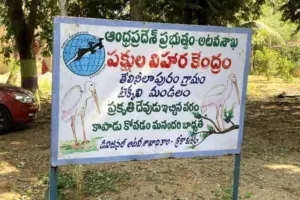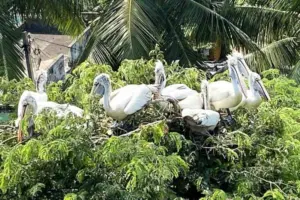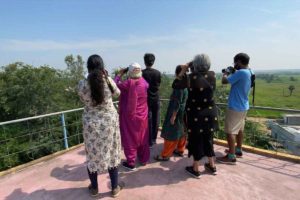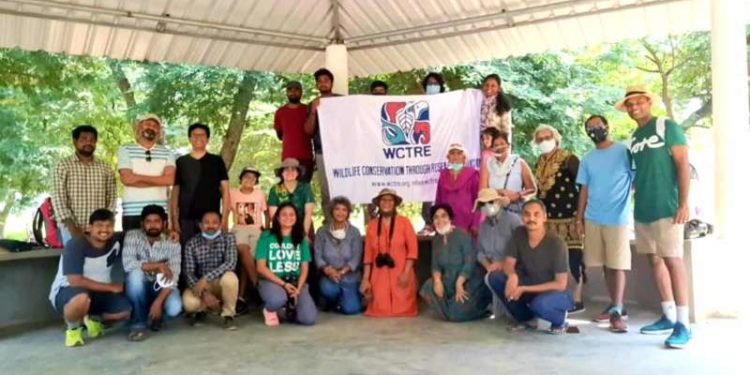Located 65 km from Srikakulam, Telineelapuram has been the winter home to a variety of migratory birds for several decades. In order to explore nature’s beauty at Telineelapuram, Vizag-based Heritage Narrator, Jayshree Hatangadi recently organised a trip to the place with close to 30 curious birdwatchers joining the bandwagon.
Turning back a few leaves in the history of Telineelapuram, the Heritage Narrator shared that rich in wetlands and mangroves, the site was demarcated as an Important Bird and Biodiversity Area (IBA) in 2004. Over 70 species of terrestrial birds, including domestic and international migratory, can be spotted at Telineelapuram, Ms Hatangadi added. Differentiating between Bird Sanctuaries and IBAs, she said, “Bird Sanctuaries are those with huge water bodies where several species of birds come together for nesting, breeding, and feeding their offsprings. Whereas the IBAs are comparatively small areas, identified to have a uniqueness in their formation, may it be the salt or the protein content available in the particular area, that has been attracting the birds over a long period of time.”

Image Credits: Facebook/Jhatangadi
Sharing the details about the trip, she said, “I truly believe that we are able to observe things better only when we are conscious about it. A quick introductory talk made the participants more aware and helped them appreciate the beauty of their surroundings. We also had an ornithologist making the session more insightful. Bhagyasree Venugopal, who had previously worked with the Salim Ali Centre for Ornithology and Natural History (SACON), revealed interesting details about the physicality, behaviour of these migratory birds, making it an engaging event.”

Image Credits: Facebook/Jhatangadi
Later on, the group of bird lovers from Vizag visited the viewing gallery. Narrating the scene observed from the gallery, Ms Hatangadi said, “One can get a clear view of the wetlands mangroves from the top. There were predominantly two families of birds i.e., Spot-billed spotted pelicans and painted storks. Our focus was the 2 varieties that were up close & right there in the trees. Spot-billed Pelicans are huge, grey coloured on the anterior and white on the posterior side. The Painted Stork (Mycteria leucocephala), on the other hand, is a large wader in the stork family. Their distinctive pink tertial feathers of the adults give them their name. After observing for a while, one can differentiate older family from the younger family. It was interesting to see birds bringing twigs to make their nests and the playful juveniles flying around. Herons, Cormorants, Egrets, Plovers, Ducks, Goose, Dunlins, Whimbrel, and Terns were some of the interesting species that were spotted while we drove around the wetlands.”

The group then arrived at the interpretation centre of Telineelapuram. “Set up by the Andhra Pradesh Forest Department, the centre was designed to offer an experience even to those who visit the place during the off-season. The interpretation centre houses life-size statues of the migratory birds. Sculpted in fibreglass, an artist named Nagarjuna designed these statues. With mangroves and wetlands in the background, the scene depicts villagers sitting nearby as the winged friends arrive,” she said.
Shedding light on the environmental hazards the Important Bird Area of Telineelapuram has endured, Ms Hatangadi said, “During the early 2000s, the East Coast Energy Thermal Project was planned to be set up in the midst of the habitat. With several activists raising their voices against the decision, the project was shelved. However, the happiness was short-lived as nature unleashed its fury. In the following years, Cyclone Nilam and Cyclone Hudhud devastated the flora and fauna in the area. Telineelapuram, which was home to around 10,000 migratory birds, a decade ago, has less than 2,000 winged friends now. On a brighter note though, water bodies in the biodiversity area have multiplied over the last four years.”
The Vizag-based Heritage Narrator also pointed out that the IBA needs to be properly maintained. “The washroom has no running water and its door is missing,” she said. Despite these flaws, Telineelapuram seemed to have won the hearts of the birdwatchers. Sharing that all of them bonded over the experience, Ms Hatangadi said, “For an interpretation centre of that size, it should ideally take about 20 minutes to tour around the place. By the end of our visit, all the participants had found a connection with the feathered creatures. As we bade farewell, each of us was looking at the place to get the final glimpse of the IBA as we drove away from the abode of migratory birds.” The Heritage Narrator is chalking out plans to conduct two more similar trips to Telineelapuram in December. Those who are interested can contact Jayshree Hatangadi at 9441225338.










Discussion about this post